You can walk around any neighborhood, look at the roofs, and see different things coming through and/or sitting on the roof. These roof penetrations all serve a certain purpose to help your roof and home function correctly.
They all have an important role, but none are more crucial than the roof vents. They are the key to your home breathing correctly, while also playing a huge role in your roof’s lifespan and energy bills.
Roof vents come in different shapes and sizes, but you’ll still need to pick the right one. Well, you can’t do that without knowing the most popular types.
For over 30 years, the team at Bill Ragan Roofing has taken pride in giving homeowners the power to make the right decisions on their own. Now, I’ll help you choose the right roof vent for your attic’s ventilation system.
This article answers the following questions:
- How does your attic’s ventilation system work?
- What are the types of active roof vents?
- What are the types of passive roof vents?
- What’s the most popular type of intake vent?
How does your attic’s ventilation system work?
Your attic’s ventilation is a system that allows your home and roof to breathe. It works by pulling fresh air into your attic through intake vents and allowing trapped air to escape through exhaust vents.
There are two types of attic ventilation systems (active and passive) that get their name from how they move air through your attic. Active attic ventilation actively pulls fresh air with a drawing effect while pushing out the trapped air.
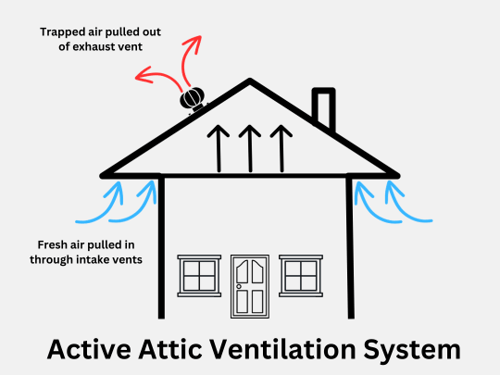
On the other hand, passive attic ventilation only moves air in and out using natural sources, like wind. Each system comes with different styles of exhaust roof vents to choose from, but the intake vents can be interchangeable with both.
Both ventilation systems do their job, but you need the right amount of ventilation for the attic space to avoid costly problems.
What are the types of active roof vents?
Active roof vents are always working to move air in and out of your attic. However, they do it in different ways.
The four most popular active vents are turbine, power, solar-powered, and ridge vents with a baffle.
Turbine roof vents
Turbine vents (also known as whirly birds) use a drawing effect through convection (heat rising) to pull fresh air and trapped air out. As long as it’s installed correctly, the air in your attic is moved around 10-12 times per hour.
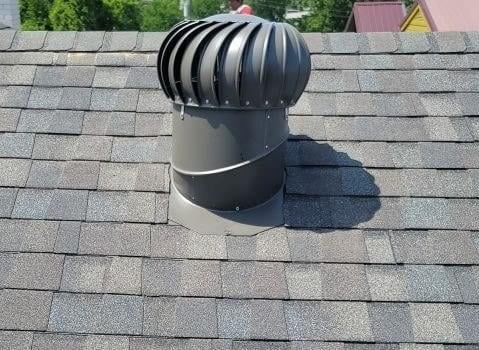
Just know that turbine vents need wind to be fully effective, but natural convection moves air in and out, even on calm days. Even though some wind is required, the vent itself still actively pulls air out.
There’s also a misconception that because their slats make them open-aired in the attic, rain, snow, and insects can enter your home through them. However, this won’t happen unless the turbine vent is damaged or installed incorrectly.
Power roof vents
Power roof vents are circular-shaped with very low profiles installed near a roof’s ridge. They use electricity to pull hot air from the attic, so there is an impact on your energy bill.
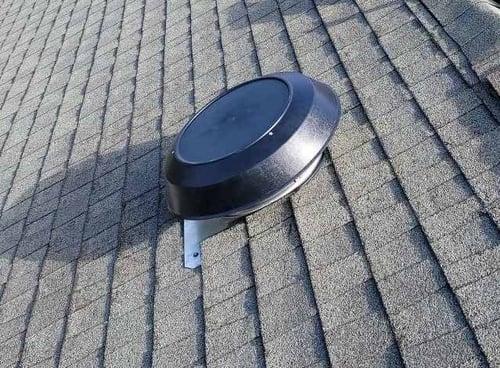
However, it comes out in a wash because a properly ventilated attic decreases your home’s overall energy bills. The real drawback is that power vent motors tend to fail, which means replacing them at some point.
You’ll also need an electrician to hook it up after the roofers install it for safety and insurance purposes. During the winter months, it’s recommended to run power vents with a humidistat to avoid humidity buildup.
This prevents condensation from forming in your attic, which leads to mildew growth and shortens your roof’s lifespan.
Solar powered roof vents
Solar powered vents are pretty much power vents, but their power source is the sun. These vents are great from an energy-saving standpoint, but the vent turns off while charging.
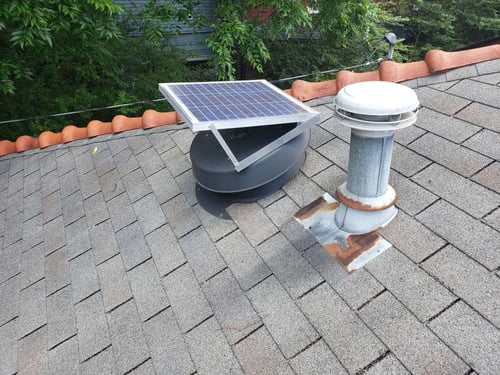
Unfortunately, they don’t hold a charge long enough to run the vent all day due to the power required to run the motor. This means your air conditioner may run more while the battery is recharging, which causes your energy bill to go up.
Ridge vents with a baffle
Ridge vents (also called filtered) run horizontally across the peaks (ridges) to let air escape through the top of your roof. They are extremely popular because they aren’t noticeable from the ground, unlike the other active vents.
-1.jpg?width=500&height=364&name=RidgeVent%20(2)-1.jpg)
Ridge vents are directly cut into the roof ridge and go all the way across the roof line to provide plenty of space to push hot air out. A ridge vent is only active if it has a baffle (filter) that provides a channel for air to flow.
Another reason the filter is great is that it prevents insects, debris, rain, and snow from entering the attic.
What are the types of passive roof vents?
Unlike active vents, passive roof vents have no moving parts, create no noise, and are virtually maintenance-free. However, needing natural forces (wind and convection) to move air around means there’s nothing in place that’s continuously working.
The most commonly used passive roof vents are box, ridge vents without a baffle, and gable end vents.
Box roof vents
Box roof vents (also called static, turtle, and louver vents) look like little boxes sitting on your roof. They allow air to escape as heat in your attic rises and pushes the hot air through the vents.
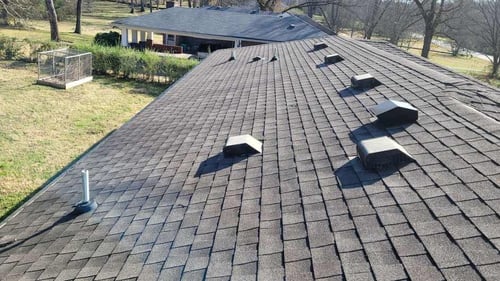
Box roof vents are commonly used in areas that aren’t a good fit for ridge vents because the ridge doesn’t extend across the roof. They aren’t as effective as active roof vents, which is why it takes a lot more to properly ventilate an attic.
Some homeowners avoid box vents for this very reason because they don’t like the look of them scattered across their roof.
Ridge vents without a baffle
Like the active version, a ridge vent is cut directly into the roof’s ridge and runs the entire length. The only difference is that there’s no baffle or filter to prevent debris, rain, snow, or insects from entering your attic.
However, it still pushes out plenty of hot air because it goes across the entire roof ridge. While there’s nothing wrong with getting this ridge vent, I recommend spending the extra money to get the filter.
Gable end vents
A gable end vent is a wooden vent on an attic’s exterior wall below where the two slopes of a roof meet. This vent relies on wind coming from outside to move the air in and out of your attic using horizontal ventilation.

If both sides of the attic have gable end vents, air can come in one side and exit out the other side. However, it’s also common to see one on the exterior wall paired with a ridge vent on the roof.
Unfortunately, the cross breeze created by horizontal ventilation hinders the effectiveness of the roof ridge’s vertical ventilation. That’s why gable ends are falling out of fashion on new builds.
What’s the most popular type of intake vent?
Now you know the most popular types of passive and active roof vents. But remember, all the roof vents above are the exhaust (except gable end vents, which can act as both) for your attic’s ventilation system.
While there are multiple intake vents, the most popular is a soffit vent (specifically, a continuous soffit vent). The soffit is beneath the eaves (the gutter line) and connects the roof’s lower edge to the home’s exterior walls.
Continuous soffit vents run the full length of your roof’s eaves and are covered with perforations that allow air to enter the attic. This creates a large surface area for increased airflow, which is why it’s the most popular intake vent contractors use.
While continuous soffit vents are the most popular, there are also individual soffit vents. They look like small boxes and are about 5 feet apart across the soffit.
How many roof vents do you need to properly ventilate your attic?
Now you know the most popular types of exhaust roof vents and the most commonly used intake vent. Remember, your attic must have the proper amount of ventilation to avoid costly problems.
And the way to do this is by ensuring your home has the right amount of vents for your attic space. However, there’s no one size fits all.
In fact, each roof vent covers a specific amount of free air space. This means the number of vents your roof needs to ventilate your attic properly depends on the one you choose.
That’s why I wrote another article breaking down how many vents you’ll need for your attic space.
Check out How Much Attic Ventilation Do I Need to learn the number of roof vents needed to properly ventilate your attic based on its square footage.



